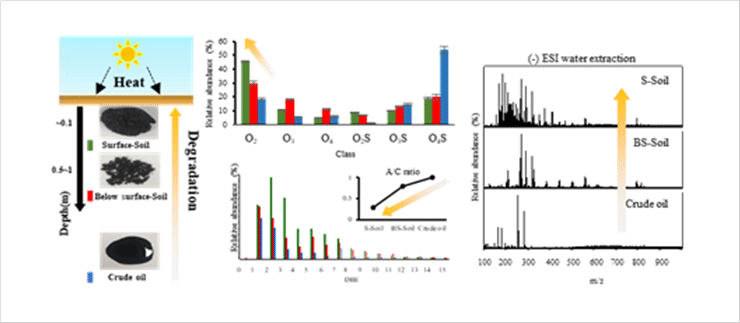Representative Research Publications
Molecular-Level Investigation of Soils Contaminated by Oil Spilled during the Gulf War 2019 > Representative Research Publications > Research Results Home
Molecular-Level Investigation of Soils Contaminated by Oil Spilled during the Gulf War
- J. Hazard. Mater. / July 2019
- Young Hwan Kim (Corresponding author)
Study Summary

In this study, molecular-level chemical compositions of soils contaminated by oil spilled during the Gulf War were studied. Two soil samples, respectively collected at 0.1m and between 0.5 and 1m below the surface from an oil spill site, were extracted with organic solvents and water. The extracts were analyzed via ultrahigh resolution FT-ICR and two-dimensional gas chromatography/high resolution mass spectrometry. The data showed that the spilled oil was significantly affected by vaporization due to high surface temperatures in the desert. The data obtained with (+) atmospheric pressure photo ionization (APPI) and (-) electrospray ionization (ESI) coupled with ultrahigh resolution–mass spectrometry (UHR-MS) indicated that the degradation of aromatic compounds and increase in oxygen-containing classes occurred in the following order: surface soil > below surface soil > crude oil. The oxygenated compounds were confirmed by principal component analysis. The score and loading plots of Ox and SOx showed that they were the major contributors to differentiate the samples. However, a comparison with previously reported oceanic oil spills. The reason for this can be attributed to the thick oil layer covering the area, resulting in less oxygen available for degradation. In addition, less biodegradation may have occurred because of arid environment. Microbes should be inactive in the desert environment and if no strong biodegradation occurred in the environment, it is not surprise that the oils changed little in composition. Third, our results showed that chemical compositions differ between contaminated soils at different depths from the surface, for example, water-extractable polar compounds were more abundant in the S-Soil than in the BS-Soil extract. Consequently, different remediation processes may be required to address these differences in the chemical composition of oil-contaminated soil in Kuwait. showed that less significant degradation occurred even after almost 30 years.



